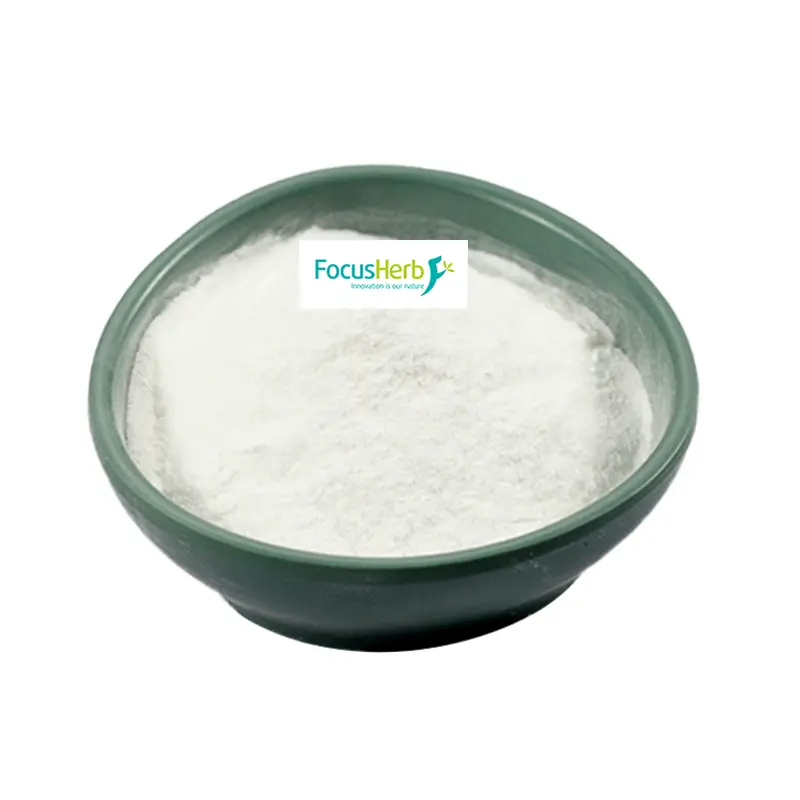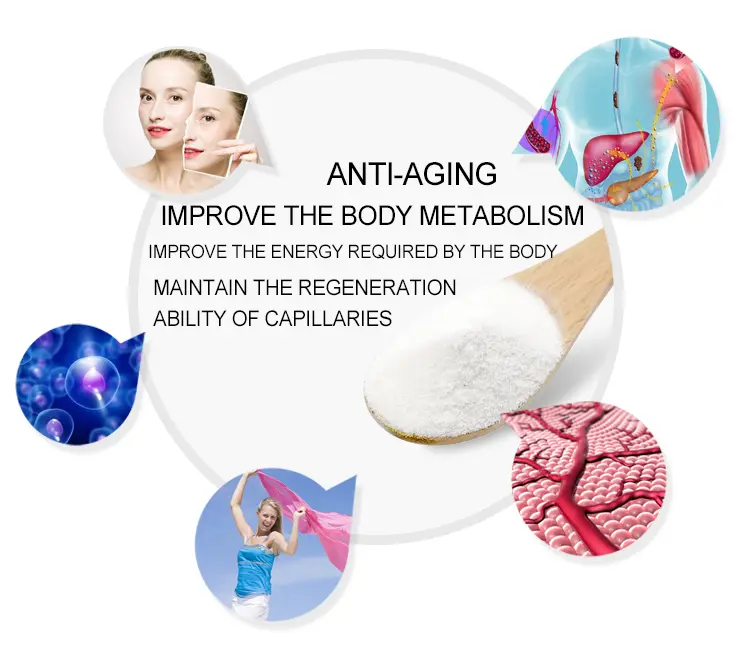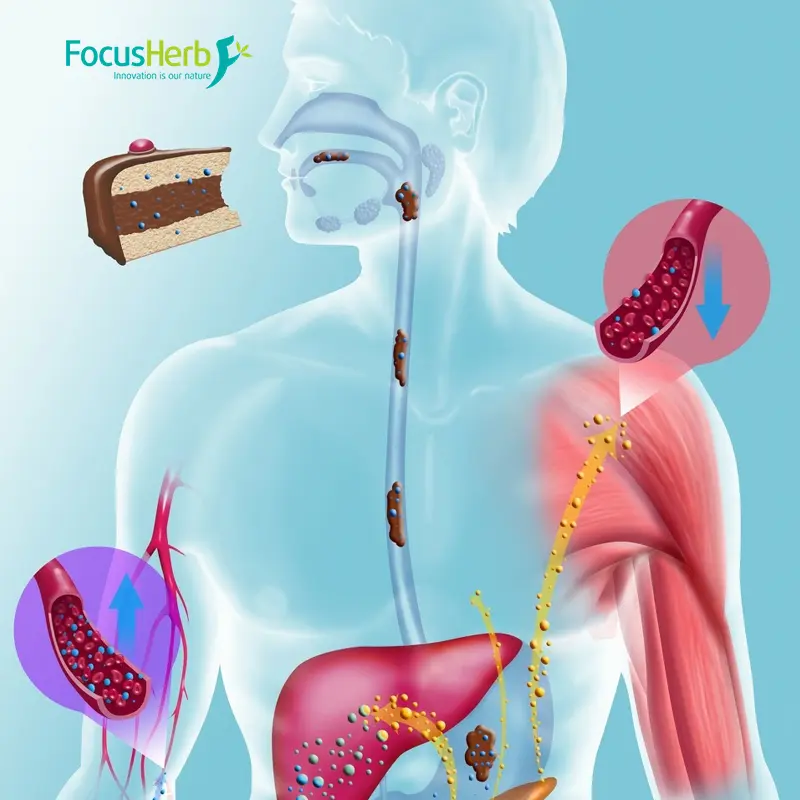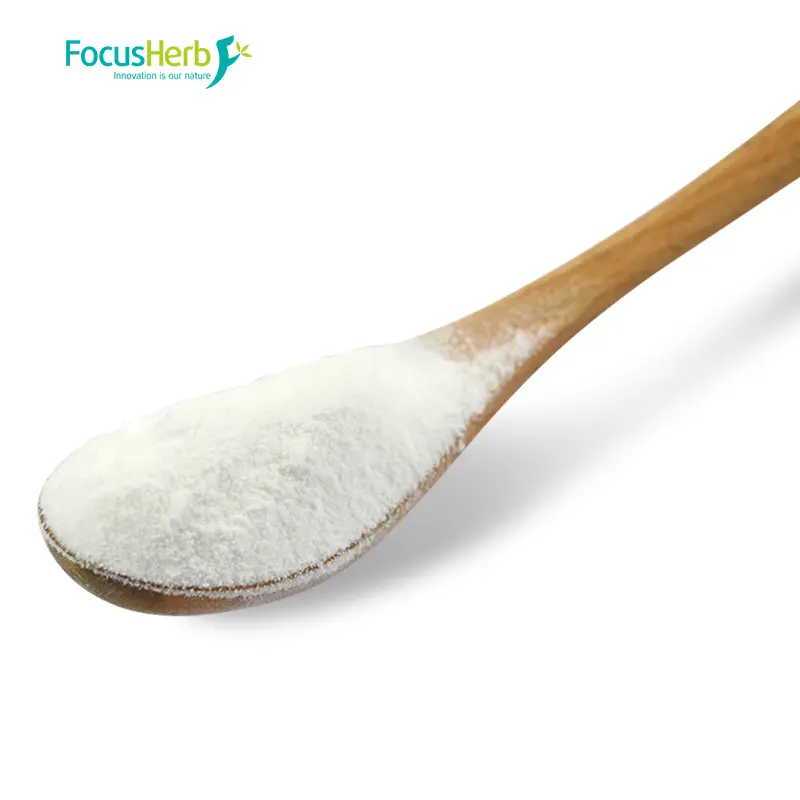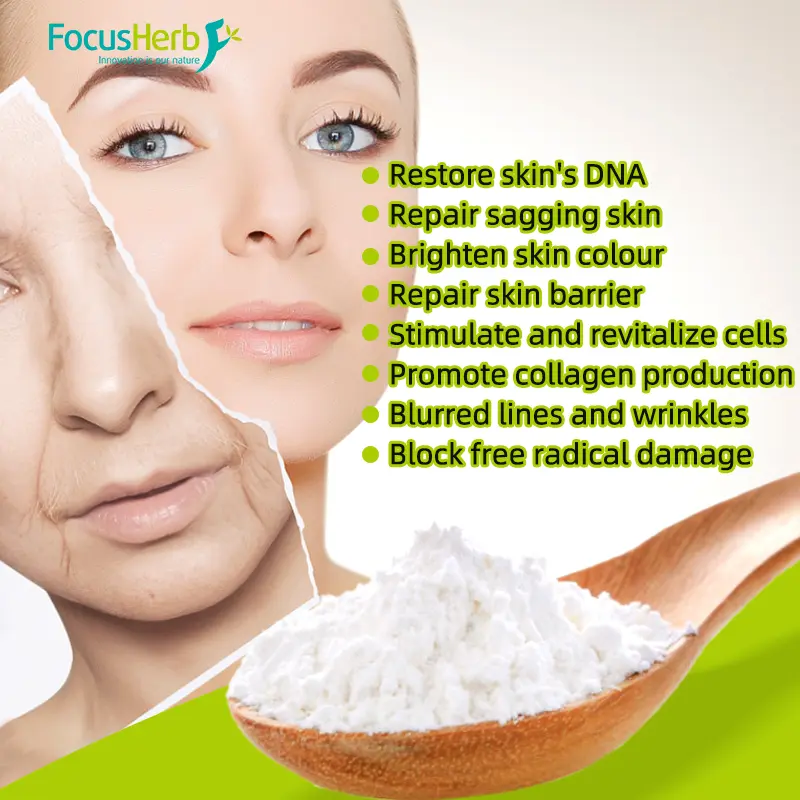NMN, or β-nicotinamide mononucleotide, is a direct precursor of NAD+ and a naturally occurring bioactive nucleotide in the human body. Its molecular structure consists of a nicotinamide group, a ribose sugar, and a phosphate group. Only the β-isomer is biologically active. It is highly soluble in water and weakly acidic (pH 3-4), requiring storage away from light and water to maintain its activity. NMN is abundant in fruits and vegetables such as avocados and edamame, and can also be synthesized by the human body. However, with aging, the body’s ability to synthesize NMN decreases, leading to a decrease in levels. Researchers have used advanced detection techniques to accurately measure NMN levels in people of different age groups and found a clear negative correlation with aging, laying the foundation for further research on the relationship between NMN supplementation and anti-aging.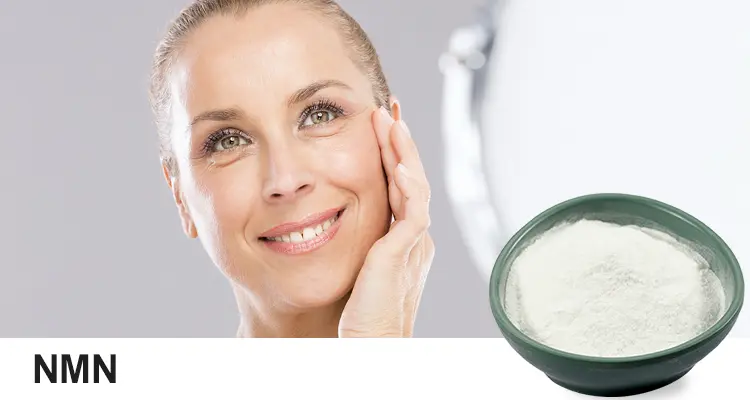
Analysis of Biological Metabolic Pathways
NMN is rapidly converted into NAD+ within cells and participates in over 300 biochemical reactions, with key roles in mitochondrial energy metabolism and DNA repair pathways. In the mitochondria of cells, NAD+ acts as a key coenzyme, participating in important energy metabolism processes such as the tricarboxylic acid cycle and oxidative phosphorylation, providing a continuous supply of energy for cellular life. Regarding DNA repair, when cells are damaged by ultraviolet light, chemicals, or other factors, NAD+-dependent repair enzymes are activated to repair damaged DNA and maintain genetic stability.
With aging, NAD+ levels decline by approximately 50% every 20 years, leading to the decline of mitochondrial function and the accumulation of DNA damage, becoming a major contributor to aging and related diseases. This phenomenon has been validated in numerous animal experiments and clinical studies. For example, studies on aged mice have found that NAD+ levels are significantly lower than those in young mice, resulting in a significant decrease in mitochondrial energy production efficiency and a significant increase in sites of DNA damage, leading to the development of aging-related hallmarks such as graying hair and decreased motor function.
NMN’s Core Benefits: Multi-Dimensional Health Benefits Based on Scientific Verification
(I) Anti-Aging and Cellular Rejuvenation
NMN’s core benefit focuses on intervening in aging at the cellular level, with the key being the activation of the Sirtuins family of longevity proteins. This family of proteins plays a central role in regulating the cellular aging process, delaying cellular aging through multiple mechanisms. Regarding DNA damage repair, with aging and the influence of external environmental factors, cellular DNA accumulates damage. When NMN increases NAD+ levels, activated Sirtuins recruit relevant DNA repair enzymes to precisely locate and repair damaged DNA fragments, ensuring accurate transmission of genetic information and maintaining normal cellular function.
Mitochondria, the “energy factories” of cells, directly determine their vitality. NMN enhances the efficiency of the mitochondrial respiratory chain, facilitating a smoother tricarboxylic acid cycle and generating more ATP, providing sufficient energy for cells. Furthermore, NMN strengthens the mitochondrial antioxidant defense system, reducing the accumulation of reactive oxygen species (ROS) and alleviating oxidative stress damage to mitochondria and cells. In a classic experiment conducted by Harvard Medical School, continuous NMN supplementation in elderly mice surprisingly improved their muscle endurance. In a treadmill test, the mice’s exercise time and distance were significantly increased compared to the control group. Skin elasticity also improved significantly, with increased collagen content and fewer wrinkles. A comprehensive assessment of these indicators revealed a 20% reversal of the mice’s aging process, strongly demonstrating the remarkable efficacy of NMN in the anti-aging field. A molecular investigation revealed that NMN not only directly impacts the cellular aging process through the aforementioned pathways but also exerts effects on multiple key aging intervention targets, such as telomere protection and autophagy activation. Telomeres, the protective caps at the ends of chromosomes, shorten with cell division. When telomeres shorten to a certain extent, cells enter a state of senescence or apoptosis. NMN activates the relevant telomerase, maintaining telomere length and delaying cellular aging. Regarding autophagy, the signaling pathways activated by NMN prompt cells to promptly remove damaged organelles and protein aggregates, maintaining a clean and homeostatic intracellular environment and further contributing to cellular rejuvenation.
(II) Metabolic and Organ Function Regulation
Metabolic Health: NMN has demonstrated significant effectiveness in regulating metabolic health. A representative clinical study conducted by Osaka University included a number of subjects with abnormal metabolic indicators and administered a daily 250mg NMN supplement for three months. The results were astonishing. The subjects’ insulin sensitivity increased significantly by 19%, meaning their cells became more responsive to insulin and more efficiently absorbed and utilized glucose in the blood, thereby stabilizing blood sugar levels and reducing the risk of metabolic diseases such as diabetes. Triglyceride levels also decreased by 15%. As a key component of blood lipids, a decrease in triglycerides can help improve lipid metabolism disorders and reduce the risk of diseases such as fatty liver and atherosclerosis. From a metabolic pathway perspective, NMN activates a series of key enzymes and signaling pathways involved in glucose and lipid metabolism by increasing NAD+ levels. For example, it enhances the activity of fatty acid oxidation enzymes in the liver, promoting lipolysis and reducing fat accumulation. It also modulates the insulin signaling pathway, enhancing the effectiveness of insulin and optimizing blood sugar metabolism. Cardiovascular Protection: NMN has diverse and profound mechanisms of protective action on the cardiovascular system. Regarding improving endothelial function, it promotes the release of nitric oxide (NO) from endothelial cells. NO is a potent vasodilator that relaxes vascular smooth muscle and dilates blood vessels, thereby lowering blood pressure, increasing vascular elasticity, and reducing the risk of cardiovascular disease. Studies have shown that NMN supplementation enhances the activity of nitric oxide synthase (eNOS) in endothelial cells and significantly increases NO production, effectively improving endothelial dysfunction. Atherosclerosis is a key pathological basis of cardiovascular disease. NMN significantly reduces the arteriosclerosis index by inhibiting inflammation and reducing oxidative stress. In animal studies, NMN supplementation in elderly mice reduced inflammatory cell infiltration in their vascular walls, lowered levels of oxidative stress markers, effectively inhibited the formation of atherosclerotic plaques, and significantly improved vascular wall elasticity and compliance. A 2023 study published in Scientific Reports directly confirmed that NMN’s effect on systolic blood pressure is comparable to that of moderate-intensity exercise. This discovery offers a new approach to maintaining cardiovascular health for those whose physical limitations prevent them from exercising regularly. Supplementing with NMN could potentially achieve cardiovascular benefits similar to those of exercise, such as lowering blood pressure and improving vascular function. This opens up new avenues for the prevention and adjunctive treatment of cardiovascular disease.
Neuroprotection: In the field of neuroprotection, the mechanism of action of NMN is of great research interest in Alzheimer’s disease, a neurodegenerative disease that severely impairs cognitive function in the elderly. One of the primary pathological hallmarks of Alzheimer’s disease is the abnormal accumulation of beta-amyloid protein in the brain. These plaques disrupt connections between neurons, interfere with neural signaling, and lead to cognitive decline. NMN can regulate related metabolic pathways and gene expression, promoting the degradation and clearance of beta-amyloid protein and reducing its accumulation in the brain. Furthermore, NMN can enhance synaptic plasticity, strengthening connections between neurons and enhancing signaling efficiency. Synaptic plasticity is the neurobiological basis of learning and memory. NMN activates related signaling molecules and protein kinases, promoting the growth, development, and maintenance of synapses, improving neurotransmission, and thereby enhancing cognitive ability. The research results, published in Nature Neuroscience, provide strong theoretical support for the role of NMN in neuroprotection and the prevention and treatment of Alzheimer’s disease. They also raise new hope for the development of novel therapeutic strategies for neurodegenerative diseases. Perhaps in the future, NMN could become an important tool for preventing and alleviating neurological disorders such as Alzheimer’s disease.
(III) Potential Risks and Controversies
Although NMN has demonstrated numerous positive health benefits, long-term supplementation carries potential risks. Regarding metabolites, NMN produces nicotinamide (NAM) during metabolism. Long-term, high-dose NMN supplementation can lead to NAM accumulation. Animal studies provide strong evidence for this. High-dose NMN supplementation (>1000mg/kg/day) has been shown to cause hepatic steatosis in experimental animals. This is because excessive NAM interferes with the liver’s lipid metabolism pathways, causing abnormal fat accumulation within liver cells, impairing normal liver function. Long-term accumulation can lead to liver diseases such as non-alcoholic fatty liver disease. Individual differences are also a significant issue. The human body’s absorption and utilization efficiency of NMN varies significantly, primarily due to differences in NMNAT enzyme activity. The NMNAT enzyme is responsible for catalyzing the conversion of NMN to NAD+. Due to genetic polymorphisms and other factors, some people have lower NMNAT enzyme activity in their bodies, resulting in an inefficient conversion of NMN to NAD+ and insufficient absorption efficiency. This results in the same dose of NMN supplementation producing widely varying effects in different individuals. Some may experience significant health improvements from NMN, while others experience minimal effects, or even develop misunderstandings or dissatisfaction due to ineffective supplementation. This poses challenges to the widespread application and precise intervention of NMN. Developing personalized NMN supplementation regimens based on individual metabolic differences is a key area of research for future research.
Market Status and Industry Ecosystem: From Unbridled Growth to Regulated Development
Global Market Landscape and Technological Pathways
Globally, the NMN market is booming and demonstrates enormous potential. According to forecasts from professional market research institutions, the global NMN market is expected to soar to US$12 billion by 2025. This rapid growth reflects the growing popularity of NMN in the health sector. In terms of market distribution, Japan and the United States, with their advanced scientific research capabilities and mature health industry systems, dominate the high-end NMN market. Japanese companies focus on product quality and R&D innovation, and their NMN products are renowned for their high quality and purity, earning them consumer trust. The United States, with its strong investment in scientific research and marketing capabilities, has achieved significant success in NMN technology development and market expansion, with numerous well-known brands emerging in the US and expanding globally.
Currently, three major technical routes for NMN production have emerged, each with its own unique advantages and characteristics. The bioenzymatic method, as one of the mainstream technologies, offers significant advantages. The NMN it produces has an extremely high purity of ≥99.9%, ensuring the highest possible quality and safety. Take Yishenghao 21000, for example. This product is produced using a bio-enzymatic method, achieving a purity of 99.99% and passing strict third-party certification. Furthermore, during the production process, advanced enzyme directed evolution technology is used to mimic the body’s natural synthesis of NMN, making the product more easily absorbed and utilized by the body, effectively enhancing NMN’s biological activity and efficacy. While chemical synthesis offers the advantage of low cost, which can reduce product prices and improve market competitiveness, the NMN produced by this method contains high levels of impurities, which may affect product safety and efficacy. These impurities may trigger adverse reactions in the body, reduce the purity and activity of NMN, and thus affect its metabolism and efficacy in the body. Fermentation is a more environmentally friendly production method that aligns with the concept of sustainable development. However, this method currently suffers from limited yields, resulting in relatively high production costs and a difficulty in meeting large-scale market demand. During the fermentation process, microbial growth and metabolism are affected by various factors, making it difficult to significantly increase NMN production, limiting its widespread market application.
Chinese companies are continuously increasing their R&D investment in the NMN field, achieving significant breakthroughs through technological innovation. Significant progress has been made in bio-enzyme technology, achieving a 37% reduction in raw material costs. This cost reduction has made NMN products more price competitive in the market, benefiting more consumers. These technological breakthroughs by Chinese companies have not only enhanced their position in the global NMN market but also driven the development of the entire industry, promoting the widespread adoption and application of NMN products.
Scientific Usage Guide: Dosage, Combination, and Purchasing Strategies
(I) Safe Dosage and Suitable Populations
For healthy adults, the recommended daily NMN supplementation dose is 200-500mg. This dosage range is based on extensive scientific research and clinical trials. In practice, it is recommended to take NMN in one or two divided doses with meals to better promote its absorption and utilization. Taking NMN with meals can help mitigate the damage of NMN caused by stomach acid by creating a mild environment in the gastrointestinal tract. It also helps NMN interact synergistically with nutrients in food, increasing its bioavailability.
The suitability of NMN for different populations varies, so caution is advised. Pregnant and breastfeeding women are in special physiological states, and the potential effects of NMN on the fetus or infant are unknown. To avoid potential risks, NMN should be strictly avoided. Minors are in a critical period of growth and development. Their NAD+ levels are relatively sufficient, and their own metabolic systems are able to meet normal growth needs. Therefore, supplementing with NMN may not only provide no benefit but may also interfere with normal growth and development, making it unsuitable. For patients with liver and kidney disease, NMN metabolism and excretion may be affected due to impaired liver and kidney metabolic function, increasing the burden on the liver and kidneys and worsening their condition. Therefore, NMN should also be avoided.
Diabetic patients should exercise extreme caution when considering NMN supplementation. While NMN may help regulate metabolism to a certain extent, it may affect blood sugar. During NMN supplementation, diabetic patients must closely monitor blood sugar levels so that treatment plans can be adjusted promptly. Furthermore, diabetic patients taking glucose-lowering medications such as metformin should avoid combining NMN with them. Metformin primarily lowers blood sugar by inhibiting hepatic glucose output and increasing glucose uptake and utilization by peripheral tissues. NMN’s modulation of metabolic pathways may interfere with metformin’s mechanism of action, affecting its efficacy and even causing adverse reactions such as hypoglycemia. A six-month follow-up study published in Frontiers in Nutrition in 2025 provided strong evidence for the safety of NMN. The study involved a group of healthy subjects taking 500mg of NMN daily. Comprehensive monitoring of the subjects’ physical indicators throughout the follow-up period revealed that no toxic reactions, such as elevated transaminases, occurred in the 500mg/day group. This demonstrates the safety of NMN at this dose and provides important guidance for consumers when choosing an NMN dosage.
(II) Enhancement Plans and Ingredient Compatibility
Optimizing Absorption: Choosing an enteric-coated formulation is a key strategy for improving NMN absorption. Enteric-coated formulations utilize a special coating technology that effectively resists the damage of gastric acid. Research data shows that the breakdown rate of high-quality enteric-coated formulations in gastric acid is controlled to less than 5%, which means that more NMN can pass through the stomach intact and reach the small intestine for absorption. The small intestine is the primary site of nutrient absorption, and NMN is more efficiently absorbed into the bloodstream there, thereby increasing its bioavailability. In addition to enteric-coated formulations, combining them with black pepper extract is another effective absorption optimization method. Black pepper extract contains piperine, which can significantly enhance NMN absorption. Studies have shown that piperine can increase NMN absorption by 30%. Piperine modulates the activity of transport proteins in intestinal cells, increasing the binding of NMN to these transporters and promoting transmembrane entry, thereby improving NMN absorption and utilization.
Synergistic Ingredients: The synergistic combination of NMN and other ingredients can deliver even more powerful health benefits. The combination of NMN and PQQ (pyrroloquinoline quinone) has attracted significant attention. PQQ is a novel water-soluble vitamin that plays a crucial role in regulating cellular metabolism and mitochondrial function. Studies have shown that the combined use of NMN and PQQ can increase mitochondrial biogenesis by 40%. This is because PQQ activates signaling pathways related to mitochondrial biogenesis, promoting mitochondrial proliferation and improved function, while the NAD+ provided by NMN provides critical support for mitochondrial energy metabolism. Together, the two enhance cellular energy supply and metabolic activity. The combination of NMN and Coenzyme Q10 also offers significant advantages. Coenzyme Q10 is a natural antioxidant found in human cells and plays a crucial role in cardiac energy metabolism. When combined, NMN and Coenzyme Q10 can enhance cardiac energy supply by 25%. In heart cells, Coenzyme Q10 participates in the electron transport chain, promoting ATP production, while NMN’s increased NAD+ levels further optimize energy metabolism. These two ingredients work synergistically to provide the heart with more energy, helping maintain normal heart function and reducing the risk of cardiovascular disease. Currently, NMN’s combination with these ingredients has been granted multiple patents, which not only recognizes its scientific and innovative nature but also provides consumers with more proven, high-quality product options.
Contraindications: When taking NMN, be careful not to take it with niacin (vitamin B3). Niacin is also involved in NAD+ synthesis in the body. When NMN and niacin are taken together, competitive inhibition of the NAD+ synthesis pathway may occur. This is because they compete for the same enzymes and substrates in the NAD+ synthesis process, thus affecting the normal efficiency of NAD+ synthesis. To avoid this interaction, the two should be taken at least two hours apart. This allows the body ample time to metabolize and utilize them separately, ensuring smooth NAD+ synthesis pathways and fully realizing the health benefits of both NMN and niacin.
(III) Key Indicators for Purchasing
Active Form: When purchasing NMN products, the first thing to consider is the active form. Only products labeled “β-NMN” are biologically active and can be effectively utilized by the body. β-NMN is the active isomer of NMN. Its molecular structure allows it to specifically bind to relevant enzymes and transporters within human cells, allowing it to participate in metabolic processes and increase NAD+ levels. The α-isomer, on the other hand, lacks this biological activity and cannot deliver the benefits of NMN. Some unscrupulous sellers mix the α-isomer with their products for sale. Consumers must carefully check product labels to avoid purchasing these ineffective products and ensure that the NMN they purchase is truly active β-NMN.
Purity Certification: Product purity is a key indicator of NMN quality. Products with SGS/HPLC test reports and a purity of ≥99% are preferred. SGS is an internationally recognized inspection, identification, testing, and certification organization, and its test reports are highly authoritative and reliable. HPLC (High-Performance Liquid Chromatography) is an advanced analytical technique that accurately determines the purity of NMN products. High-purity NMN products contain extremely low impurities, typically less than 0.1%, significantly reducing potential harm to the human body. For example, high-quality NMN products require heavy metal levels of ≤1 ppm. Residual levels of heavy metals and other harmful substances are strictly controlled to ensure product safety and consumer confidence.
Production Process: The production process directly impacts the quality and safety of NMN products. Enzymatic methods offer significant advantages over chemical synthesis. Enzymatic methods mimic the body’s natural NMN synthesis process, utilizing specific enzymes as catalysts and conducting reactions under mild conditions. The NMN produced by this method is highly pure, highly active, and virtually free of chemical residues, making it more compatible with the physiological needs of the human body. When choosing a product, pay attention to whether it utilizes advanced bio-enzyme technology keywords such as “holoenzyme catalysis” and “directed evolution.” Holoenzyme catalysis technology allows for more precise control of the reaction process, improving the efficiency and quality of NMN synthesis. Directed evolution technology modifies and optimizes enzymes to make them more suitable for NMN production, further enhancing product quality. While chemical synthesis is less expensive, it can use a large amount of chemical reagents during production, which can easily produce chemical residues and pose certain risks to human health. Therefore, when purchasing NMN products, avoid using chemical synthesis.
Future Outlook: Controversial Technological Breakthroughs and Industrial Upgrading
(I) Cutting-Edge Technology Directions
Delivery System Innovation: Liposome encapsulation technology demonstrates significant potential for NMN delivery system innovation. Liposomes are nanoparticles composed of a phospholipid bilayer, exhibiting excellent biocompatibility and targeted properties. Encapsulating NMN within liposomes effectively protects NMN from being destroyed by gastric acid, enhancing its stability in the gastrointestinal tract. Studies have shown that NMN products using liposome encapsulation achieve a five-fold increase in blood concentration compared to traditional products. This means that more NMN is absorbed into the bloodstream, allowing it to more effectively exert its biological activity. Nanoparticle-targeted mitochondrial delivery technology has also achieved significant breakthroughs. Mitochondria, as the cell’s “energy powerhouse,” are a key target for NMN’s activity. Using nanoparticles to deliver NMN directly to mitochondria can significantly improve NMN delivery efficiency. The research results were published in Advanced Science. Experimental data showed that this technology achieved a delivery efficiency of over 90%, enabling NMN to more precisely target mitochondria, improving mitochondrial function and providing cells with more energy, further enhancing NMN’s anti-aging and health-maintaining effects.
Synthetic Biology Breakthrough: The Chinese Academy of Sciences has achieved a revolutionary breakthrough in the field of NMN synthetic biology. Using advanced gene editing technology, the research team systematically engineered Escherichia coli and successfully developed a de novo NMN synthesis pathway in the bacterium. This innovative technology increased NMN production by over 100-fold, significantly improving NMN production efficiency. The researchers used gene editing to knock out the pncC and nadR genes. This critical step effectively blocked competing pathways in NMN synthesis, allowing more substrates to be used for NMN synthesis, significantly increasing production. Subsequently, they optimized the de novo NMN synthesis pathway and integrated it with the NadV-mediated NMN biosynthesis pathway, further improving NMN synthesis efficiency. The introduction of two transporters enhanced NAM absorption and NMN efflux, increasing NMN production to approximately 1300μM. By optimizing and modifying the PRPP synthase, NMN production exceeded 3000μM after 24 hours of shake flask fermentation. This breakthrough not only significantly increased NMN production but also significantly reduced raw material costs, projected to be down to one-third of the current level. This cost reduction will make NMN products more affordable, laying a solid foundation for its widespread adoption and enabling more consumers to enjoy the health benefits of NMN.
(II) Regulation and Industry Standardization
Globally, the US FDA has granted NMN GRAS safety certification, providing strong support for its development in the US market and enabling the legal sale of NMN products as dietary supplements. In China, as the NMN market continues to grow, regulators are also actively promoting industry regulation and standardization. Currently, China is accelerating the development of the “NMN Raw Material Quality Standard” and anticipates the introduction of a health food registration system in 2026. These measures aim to strengthen oversight of the NMN market, standardize product production and sales, and protect consumer rights. With strengthened regulation, the NMN industry will enter a phase driven by both compliance and technology. Compliance will become a fundamental barrier to market entry for companies, and only products that meet relevant standards and regulations will be marketed. Technological innovation will also become a core competitive factor for companies, requiring continuous investment in R&D to improve product quality and efficacy to meet consumer demand. During this process, the industry’s elimination rate is expected to reach 40%. Companies that fail to meet standards and have outdated technology will be eliminated from the market, while those that prioritize compliance and technological innovation will stand out, driving the industry towards a healthier and more orderly development.
(III) Scientific Controversy and Rational Positioning
Although NMN has demonstrated significant anti-aging effects in animal studies, such as extending lifespan, improving metabolic function, and enhancing cognitive ability, further data on its long-term safety in humans (>5 years) is needed. Currently, research on the long-term effects of NMN on humans is relatively limited, and its potential risks and side effects are not fully understood. Whether long-term, high-dose NMN use affects the human immune system, reproductive system, and other organs requires further clinical research. We must approach the role of NMN rationally. Its core value lies in “intervention in the aging process,” by increasing NAD+ levels, activating related signaling pathways and proteins, delaying cellular aging, and improving bodily functions. However, it is not a drug that can cure disease. In the pursuit of health and anti-aging, NMN needs to be combined with lifestyle management, such as a healthy diet and moderate exercise. A balanced diet provides the body with essential nutrients and maintains normal metabolism; moderate exercise can enhance cardiopulmonary function and improve immunity and metabolic levels. Only by organically combining NMN with these lifestyle factors can the comprehensive anti-aging effect be maximized, allowing people to maintain good living habits while enjoying the health benefits brought by NMN, and jointly promote physical health and delay aging.
Rationally Embrace New Opportunities in Scientific Anti-Aging
The rise of NMN marks a crucial step forward in anti-aging research, moving from theoretical exploration to clinical application. Its value lies not only in its breakthroughs at the cellular level, but also in the regulatory challenges of commercialization. Consumers should make rational choices based on scientific evidence, focusing on high-purity products sourced from compliant channels, and incorporating NMN into their personalized health management plans. With technological advancements and improved regulation, NMN is expected to become a key tool in the field of precision anti-aging, contributing to the continued extension of human healthy lifespan.



















